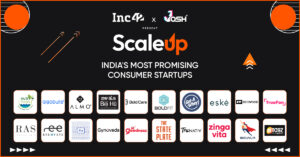Sequoia and Y Combinator-backed people management platform Mesh was founded in May 2020 to solve the unmet needs of the performance management of hyper-growth companies.
Gone are the days when we would be inclined towards HR or the tech-related components of HR for driving the specific functional HR domain. Today, HR tech is the human operating system that drives an entire organisation’s work performance. At YS’s Future of Work 2022, Gaurav Chaubey, one of the co-founders of Mesh, delivered a masterclass on why HR tech is the new work-operating system, or to simplify it, the new work tech.
The need for more than a singular monolithic HRMS
What is the need for more than one monolithic Human Resource management system (HRMS)? “The answer is simply derived from the first perspective of a people management system. The core drivers behind this shift from HR tech to work tech are based on two factors – the way we work for organisations and who works in these organisations,” explained Gaurav.
Since the mid-2010s, the world has been experiencing the Fourth Industrial Revolution, also known as Industry 4.0. The previous three industrial revolutions had seen organisations built for control and efficiency. “Information took a lot of time in moving up to the necessary authorities, in those organisations, and thereby the act of decision-making took a lot of time. And, those decisions again took time in reaching the real individuals working in the marketplace units of the organisations,” said Gaurav.
However, the advent of the fourth industrial revolution saw the predominance of knowledge work. “Today organisations are extremely organised based on a teamwork structure. The way they organise their teams and structure them serves for their speed and innovation in a truly marketing disruptive environment. Here, leaders are no longer the ones who have the privilege to acquire all the data analytics, insights, and decision making. Rather, they are the ones giving up all of these in a decentralised manner to the cross-functional teams, who come together on demand, to solve the most critical and important problems, which changes periodically,” he shared.
Boundaryless organisations are the future
According to Gaurav, the future of the work sphere is boundaryless organisations, where individual knowledge workers would have the autonomy to decide the time allocation dedicated for each project. “These would be the ones who are the real deciding factors behind whether they would like to work on a project assigned to them, as they are working as knowledge workers for several organisations. This might just be the beginning of the contractual working system that seems to have skyrocketed, leading to the birth of boundaryless organisations, to the limit where organisations ceased to have full-time employees on their payroll per se,” added Gaurav.
But how are these knowledge drivers going to decide which organisations they would like to spend more time with? “Today, knowledge workers are not just looking for pay, benefits, perks, or compensation. Just like the way businesses are moving from a profit to a purposeless model value-proposition perspective to attract customers, they are also instigating employees to work on problems that they genuinely care about,” he revealed.
Thus, employees in a boundaryless organisation are going to be the only customers for the organisations, as they are solving problems for products and services that they love to use. That sets the temperament of the human operating system of the work tech stack, or to be precise, the HR tech stack.
Tech stack tools for marketing, sales, and service
Tech tools are important to collect rich data about customers across every touchpoint of their journey. “The trick here is personalisation, and the moment we comprehend that once a customer is gained, loyalty is achieved for life, the process of making it seamless becomes an easy task,” said Gaurav.
It is essential to understand the motivation of the new-age workforce to join an organisation. Today, knowledge workers believe in using deep skills and knowledge to solve complex problems, as and when they occur. Besides, they also seek less micro-management and more autonomy with a sense of progress and building mastery in the components they touch upon. Lastly, they love being part of a well-knitted community, including a cross-functional team, and also the team they are working with.
From HR tech to work tech
As Gaurav recalled, the HRMS emerged as an effective system of record in the 1970-80s, and is still regarded as an important part of management. “Back in the days, the process was to focus on automating transactions, and the system was primarily designed to use HR payroll or finance leaders. The idea was to build a consistent experience across all the individual contributors working largely on procedural activities,” he said.
“2010 saw the shift from web-apps to mobile-first, and now the HR tech was not necessarily being designed for the process-owners or buyers of this tech. Rather, this tech was designed and sold to unleash and empower more personas within the organisations. This was the juncture that saw a late bundling in the late 2000s-early 2010s. Now, with the evolution, the present scenario states personalising the experience for employees and team members across every touchpoint of the hire-to-retire journey,” added Gaurav.
Now, the above process needs to be integrated well into the workflow, especially during this era of working remotely. Therefore, employers are encouraging their team members to share more about them, without breaking the flow of work, harming the user experience, and switching between applications.
All organisations use almost seven to nine HR tech applications across the hire-to-retire journey. However, the above line also doesn’t undermine the use of proper HRMS, serving as the backbone and the single source of truth, from an employee, payroll, and new joinee perspective, etc.
The continuous evolution of work tech
Work tech, according to Gaurav, is placed in three separate buckets – connect, reflect, and grow.
“The first one is building technology for the future, that allows and invites self-expression of every modern-day knowledge worker in the flow of work, through their real-time check-ins. Secondly, there is decentralisation of data that the organisation is collecting about these knowledge workers. Thus, it is more about reflecting self-awareness through real-time analytics for every level, and persona. Finally, leveraging the customer-facing technology, where organisations can start delivering AI-faced personalised nudges to help them develop habits,” he added.










